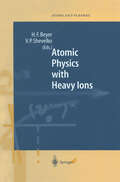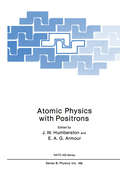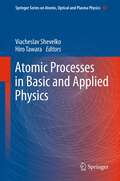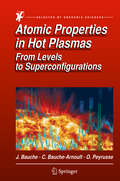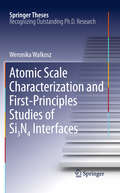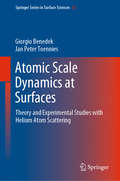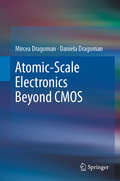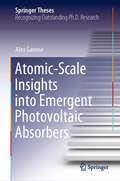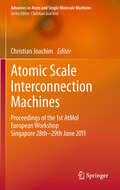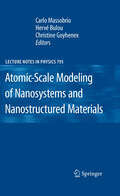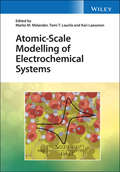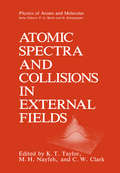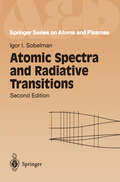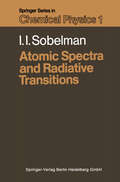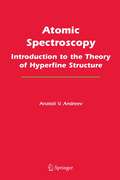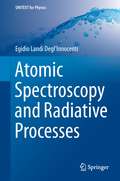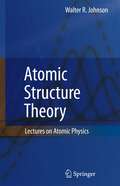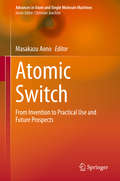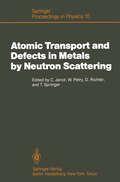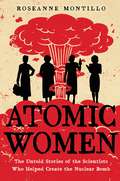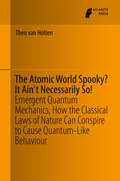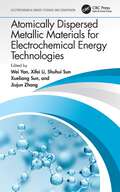- Table View
- List View
Atomic Physics with Heavy Ions (Springer Series on Atomic, Optical, and Plasma Physics #26)
by Heinrich F. Beyer Viatcheslav P. ShevelkoThis book is devoted to one of the most active domains of atomic physic- atomic physics of heavy positive ions. During the last 30 years, this terrain has attracted enormous attention from both experimentalists and theoreti cians. On the one hand, this interest is stimulated by rapid progress in the development of laboratory ion sources, storage rings, ion traps and methods for ion cooling. In many laboratories, a considerable number of complex and accurate experiments have been initiated, challenging new frontiers. Highly charged ions are used for investigations related to fundamental research and to more applied fields such as controlled nuclear fusion driven by heavy ions and its diagnostics, ion-surface interaction, physics of hollow atoms, x-ray lasers, x-ray spectroscopy, spectrometry of ions in storage rings and ion traps, biology, and medical therapy. On the other hand, the new technologies have stimulated elaborate theo retical investigations, especially in developing QED theory, relativistic many body techniques, plasma-kinetic modeling based on the Coulomb interactions of highly charged ions with photons and various atomic particles - electrons, atoms, molecules and ions. The idea of assembling this book matured while the editors were writ ing another book, X-Ray Radiation of Highly Charged Ions by H. F. Beyer, H. -J. Kluge and V. P. Shevelko (Springer, Berlin, Heidelberg 1997) covering a broad range of x-ray and other radiative phenomena central to atomic physics with heavy ions.
Atomic Physics with Positrons (Nato Science Series B: #169)
by J. W. Humberston E. A. G. ArmourThe NATO Advanced Research Workshop on Atomic Physics with Positrons, which was held at University College London during 15-18 July 1987, was the fourth meeting in a series devoted to the general theme of positron colli sions in gases. Previous meetings have been held at York University, Toronto (1981); Royal Holloway College, Egham (1983) and Wayne State Uni versity, Detroit (1985). Recent very significant improvements in positron beam currents, due to the development of more efficient moderators and the use of more intense positron sources, are making possible an increasingly sophisticated range of experiments in atomic collision physics. Whereas a few years ago only total scattering cross sections could be determined, measurements can now be made of various partial and differential cross sections. Intense positron beams are also being used to produce positronium beams and already, as reported here, preliminary investigations have been made of collisions of positronium with several target systems. These experimental developments have stimulated, and been stimulated by, steady, if somewhat less spectacu1ar,progress in associated theoretical studies. Both aspects of the field are well represented in these Proceed ings.
Atomic Processes in Basic and Applied Physics (Springer Series on Atomic, Optical, and Plasma Physics #68)
by Viacheslav Shevelko and Hiro TawaraThe book is a comprehensive edition which considers the interactions of atoms, ions and molecules with charged particles, photons and laser fields and reflects the present understanding of atomic processes such as electron capture, target and projectile ionisation, photoabsorption and others occurring in most of laboratory and astrophysical plasma sources including many-photon and many-electron processes. The material consists of selected papers written by leading scientists in various fields.
Atomic Properties in Hot Plasmas: From Levels to Superconfigurations
by Jacques Bauche Claire Bauche-Arnoult Olivier PeyrusseThis book is devoted to the calculation of hot-plasma properties which generally requires a huge number of atomic data. It is the first book that combines information on the details of the basic atomic physics and its application to atomic spectroscopy with the use of the relevant statistical approaches. Information like energy levels, radiative rates, collisional and radiative cross-sections, etc., must be included in equilibrium or non-equilibrium models in order to describe both the atomic-population kinetics and the radiative properties. From the very large number of levels and transitions involved in complex ions, some statistical (global) properties emerge. The book presents a coherent set of concepts and compact formulas suitable for tractable and accurate calculations. The topics addressed are: radiative emission and absorption, and a dozen of other collisional and radiative processes; transition arrays between level ensembles (configurations, superconfigurations); effective temperatures of configurations, superconfigurations, and ions; charge-state distributions; radiative power losses and opacity. There are many numerical examples and comparisons with experiment presented throughout the book. The plasma properties described in this book are especially relevant to large nuclear fusion facilities such as the NIF (California) and the ITER (France), and to astrophysics.Methods relevant to the central-field configurational model are described in detail in the appendices: tensor-operator techniques, second-quantization formalism, statistical distribution moments, and the algebra of partition functions. Some extra tools are propensity laws, correlations, and fractals. These methods are applied to the analytical derivation of many properties, specially the global ones, through which the complexity is much reduced. The book is intended for graduate-level students, and for physicists working in the field.
Atomic Scale Characterization and First-Principles Studies of Si₃N₄ Interfaces (Springer Theses)
by Weronika WalkoszThis thesis presents results from a combined atomic-resolution Z-contrast and annular bright-field imaging and electron energy loss spectroscopy in the Scanning Transmission Electron Microscopy, as well as first principles studies of the interfaces between crystalline β−Si3N4 and amorphous (i) CeO2-x as well as (ii) SiO2 intergranular film (IGF). These interfaces are of a great fundamental and technological interest because they play an important role in the microstructural evolution and mechanical properties of Si3N4 ceramics used in many high temperature and pressure applications. The main contribution of this work is its detailed description of the bonding characteristics of light atoms, in particular oxygen and nitrogen, at these interfaces, which has not been achieved before. The atomic-scale information on the arrangement of both light and heavy atoms is critical for realistic modeling of interface properties, such as interface strength and ion transport, and will facilitate increased control over the performance of ceramic and semiconductor materials for a wide-range of applications.
Atomic Scale Dynamics at Surfaces: Theory and Experimental Studies with Helium Atom Scattering (Springer Series in Surface Sciences #63)
by Giorgio Benedek Jan Peter ToenniesExperimental advances in helium atom scattering spectroscopy over the last forty years have allowed the measurement of surface phonon dispersion curves of more than 200 different crystal surfaces and overlayers of insulators, semiconductors and metals. The first part of the book presents, at a tutorial level, the fundamental concepts and methods in surface lattice dynamics, and the theory of atom-surface interaction and inelastic scattering in their various approximations, up to the recent electron-phonon theory of helium atom scattering from conducting surfaces. The second part of the book, after introducing the experimentalist to He-atom spectrometers and the rich phenomenology of helium atom scattering from corrugated surfaces, illustrates the most significant experimental results on the surface phonon dispersion curves of various classes of insulators, semiconductors, metals, layered crystals, topological insulators, complex surfaces, adsorbates, ultra-thin films and clusters. The great potential of helium atom scattering for the study of atomic scale diffusion, THz surface collective excitations, including acoustic surface plasmons, and the future prospects of helium atom scattering are presented in the concluding chapters. The book will be valuable reading for all researchers and graduate students interested in dynamical processes at surfaces.
Atomic-Scale Electronics Beyond CMOS
by Mircea Dragoman Daniela DragomanThis book explores emerging topics in atomic- and nano-scale electronics after the era of Moore’s Law, covering both the physical principles behind, and technological implementations for many devices that are now expected to become key elements of the future of nanoelectronics beyond traditional complementary metal-oxide semiconductors (CMOS). Moore’s law is not a physical law itself, but rather a visionary prediction that has worked well for more than 50 years but is rapidly coming to its end as the gate length of CMOS transistors approaches the length-scale of only a few atoms. Thus, the key question here is: “What is the future for nanoelectronics beyond CMOS?” The possible answers are found in this book. Introducing novel quantum devices such as atomic–scale electronic devices, ballistic devices, memristors, superconducting devices, this book also presents the reader with the physical principles underlying new ways of computing, as well as their practical implementation. Topics such as quantum computing, neuromorphic computing are highlighted here as some of the most promising candidates for ushering in a new era of atomic-scale electronics beyond CMOS.
Atomic-Scale Insights into Emergent Photovoltaic Absorbers (Springer Theses)
by Alex GanoseThis book presents an original investigation into alternative photovoltaic absorbers. Solar power is a highly promising renewable energy solution; however, its success is hampered by the limited cost-effectiveness of current devices. The book assesses the photovoltaic performance of over 20 materials using state-of-the-art, first-principles methods. Adopting a computational approach, it investigates atomic-scale properties at a level of accuracy that is difficult to achieve using laboratory-based experimental techniques. Unlike many theoretical studies, it provides specific advice to those involved in experimental investigations. Further, it proposes directions for future research. This book advances the field of photovoltaics in three crucial ways: firstly, it identifies why one class of proposed materials cannot achieve high efficiency, while at the same time gaining insights that can be used to design future absorbers. Secondly, it shows that poor performance in the bismuth chalcohalides is not due to fundamental limitations, and can be overcome by finely controlling synthesis conditions. Lastly, it describes a range of new stable materials that are expected to show excellent photovoltaic performance.
Atomic Scale Interconnection Machines: Proceedings of the 1st AtMol European Workshop Singapore 28th-29th June 2011 (Advances in Atom and Single Molecule Machines)
by Christian JoachimThis volume documents the first International Workshop on Atomic Scale Interconnection Machines organised by the European Integrated Project AtMol in June 2011 in Singapore. The four sessions, discussed here in revised contributions by high level speakers, span the subjects of multi-probe UHV instrumentation, atomic scale nano-material nanowires characterization, atomic scale surface conductance measurements, surface atomic scale mechanical machineries. This state-of-the-art account brings academic researchers and industry engineers access to the tools they need to be at the forefront of the atomic scale technology revolution.
Atomic-Scale Modeling of Nanosystems and Nanostructured Materials (Lecture Notes in Physics #795)
by Carlo Massobrio Hervé Bulou Christine GoyhenexUnderstanding the structural organization of materials at the atomic scale is a lo- standing challenge of condensed matter physics and chemistry. By reducing the size of synthesized systems down to the nanometer, or by constructing them as collection of nanoscale size constitutive units, researchers are faced with the task of going beyond models and interpretations based on bulk behavior. Among the wealth of new materials having in common a “nanoscale” ngerprint, one can encounter systems intrinsically extending to a few nanometers (clusters of various compo- tions), systems featuring at least one spatial dimension not repeated periodically in space and assemblies of nanoscale grains forming extended compounds. For all these cases, there is a compelling need of an atomic-scale information combining knowledge of the topology of the system and of its bonding behavior, based on the electronic structure and its interplay with the atomic con gurations. Recent dev- opments in computer architectures and progresses in available computational power have made possible the practical realization of a paradygma that appeared totally unrealistic at the outset of computer simulations in materials science. This consists inbeing able to parallel (at least inprinciple) any experimental effort by asimulation counterpart, this occurring at the scale most appropriate to complement and enrich the experiment.
Atomic-Scale Modelling of Electrochemical Systems
by Marko MelanderAtomic-Scale Modelling of Electrochemical Systems A comprehensive overview of atomistic computational electrochemistry, discussing methods, implementation, and state-of-the-art applications in the field The first book to review state-of-the-art computational and theoretical methods for modelling, understanding, and predicting the properties of electrochemical interfaces. This book presents a detailed description of the current methods, their background, limitations, and use for addressing the electrochemical interface and reactions. It also highlights several applications in electrocatalysis and electrochemistry. Atomic-Scale Modelling of Electrochemical Systems discusses different ways of including the electrode potential in the computational setup and fixed potential calculations within the framework of grand canonical density functional theory. It examines classical and quantum mechanical models for the solid-liquid interface and formation of an electrochemical double-layer using molecular dynamics and/or continuum descriptions. A thermodynamic description of the interface and reactions taking place at the interface as a function of the electrode potential is provided, as are novel ways to describe rates of heterogeneous electron transfer, proton-coupled electron transfer, and other electrocatalytic reactions. The book also covers multiscale modelling, where atomic level information is used for predicting experimental observables to enable direct comparison with experiments, to rationalize experimental results, and to predict the following electrochemical performance. Uniquely explains how to understand, predict, and optimize the properties and reactivity of electrochemical interfaces starting from the atomic scale Uses an engaging “tutorial style” presentation, highlighting a solid physicochemical background, computational implementation, and applications for different methods, including merits and limitations Bridges the gap between experimental electrochemistry and computational atomistic modelling Written by a team of experts within the field of computational electrochemistry and the wider computational condensed matter community, this book serves as an introduction to the subject for readers entering the field of atom-level electrochemical modeling, while also serving as an invaluable reference for advanced practitioners already working in the field.
Atomic-Scale Modelling of Electrochemical Systems
by Marko Melander Tomi Laurila Kari LaasonenAtomic-Scale Modelling of Electrochemical Systems A comprehensive overview of atomistic computational electrochemistry, discussing methods, implementation, and state-of-the-art applications in the field The first book to review state-of-the-art computational and theoretical methods for modelling, understanding, and predicting the properties of electrochemical interfaces. This book presents a detailed description of the current methods, their background, limitations, and use for addressing the electrochemical interface and reactions. It also highlights several applications in electrocatalysis and electrochemistry. Atomic-Scale Modelling of Electrochemical Systems discusses different ways of including the electrode potential in the computational setup and fixed potential calculations within the framework of grand canonical density functional theory. It examines classical and quantum mechanical models for the solid-liquid interface and formation of an electrochemical double-layer using molecular dynamics and/or continuum descriptions. A thermodynamic description of the interface and reactions taking place at the interface as a function of the electrode potential is provided, as are novel ways to describe rates of heterogeneous electron transfer, proton-coupled electron transfer, and other electrocatalytic reactions. The book also covers multiscale modelling, where atomic level information is used for predicting experimental observables to enable direct comparison with experiments, to rationalize experimental results, and to predict the following electrochemical performance. Uniquely explains how to understand, predict, and optimize the properties and reactivity of electrochemical interfaces starting from the atomic scale Uses an engaging “tutorial style” presentation, highlighting a solid physicochemical background, computational implementation, and applications for different methods, including merits and limitations Bridges the gap between experimental electrochemistry and computational atomistic modelling Written by a team of experts within the field of computational electrochemistry and the wider computational condensed matter community, this book serves as an introduction to the subject for readers entering the field of atom-level electrochemical modeling, while also serving as an invaluable reference for advanced practitioners already working in the field.
Atomic Spectra and Collisions in External Fields (Physics of Atoms and Molecules)
This volume contains papers associated with the conference "Atomic Spectra and Collisions in External Fields II", that took place July 30-31 1987 at Royal Holloway and Beford New College. The first meeting of this name was held at the National Bureau of Standards in Gaithersburg, Maryland in 1984, and, if any tradition can yet be said to have been established in the series, it is that the proceedings be written after the conference. We hope thereby to preserve some impression of the discussions that took place, which in both cases were vigorous and unihibited. Both meetings happen to have convened in proximity to major developments in the field. At the time of the first conference, results of experimental measurements of dielectronic recombination in electron ion beams were beginning to appear. These showed large discrepancies with theoretical calculations, which were attributed to the effects of rather weak electric fields on the highly-excited states that mediate the recombination process. This conjecture gave rise to widespread concern in the plasma physics community that the representation of dielectronic recombination in existing plasma models, in which it plays an important role in energy and ionization balance, might be seriously in error due to neglect of the effects of electric and magnetic fields. The subject of field effects on recombination processes was thus a major focus of the 1984 meeting.
Atomic Spectra and Radiative Transitions (Springer Series on Atomic, Optical, and Plasma Physics #12)
by Igor I. SobelmanAtomic Spectra and Radiative Transitions covers the systematics of atomic spectra, continuous spectrum radiation, and the excitation of atoms. This second edition has additional chapters on relativistic corrections in the spectra of highly charged ions, which rounds off the previous treatment. Extensive tables of oscillator strengths (both dipole and quadrupole), probabilities and cross sections of radiative transitions complete this textbook, making it invaluable also as a reference work.
Atomic Spectra and Radiative Transitions (Springer Series in Chemical Physics #1)
by I.I. SobelmanMy previous book on the theory of atomic spectra was published in Russian about fifteen years ago. Besides the traditional problems usually included in a book on atomic spectroscopy, some other problems arising in various applications of spectroscopic methods were also discussed in the book. These include, for example, continuous spectrum radiation, excitation of atoms, and spectral line broadening. Extensive revisions were made in the English version of the book published by the Pergamon Press in 1972, especially in the chapter devoted to the problem of excitation of atoms. This book is intended as the first part of a two-volume presentation of the theory of atomic spectra, atomic radiative transitions, excitation of atoms, and spectral line broadening. The aim in preparing these new books has been to stress the problems connected with the most interesting applications of atomic spectroscopy to plasma diagnostics, astrophysics, laser physics, and other fields, which have been developed very intensively in recent years. The content of this first volume, devoted to the systematics of atomic spectra and radiative transitions, is similar to that of Chapters 1-6, 8 and 9 of the old book, but considerable revision has been made. Some sections, such as those on the Hartree-Fock method, the Dirac equation, and relativistic corrections, have been deleted. At the same time, more attention is paid to radiative transitions. More extensive tables of oscillator strengths, prob abilities, and effective cross sections of radiative transitions in discrete and continuous spectra are given.
Atomic Spectroscopy: Introduction to the Theory of Hyperfine Structure
by Anatoli V. AndreevAtomic Spectroscopy provides a comprehensive discussion on the general approach to the theory of atomic spectra, based on the use of the Lagrangian canonical formalism. This approach is developed and applied to explain the hydrogenic hyperfine structure associated with the nucleus motion, its finite mass, and spin. The non-relativistic or relativistic, spin or spin-free particle approximations can be used as a starting point of general approach. The special attention is paid to the theory of Lamb shift formation. The formulae for hydrogenic spectrum including the account of Lamb shift are written in simple analytical form. The book is of interest to specialists, graduate and postgraduate students, who are involved into the experimental and theoretical research in the field of modern atomic spectroscopy.
Atomic Spectroscopy and Radiative Processes (UNITEXT for Physics)
by Egidio Landi Degl'InnocentiThis book describes the basic physical principles of atomic spectroscopy and the absorption and emission of radiation in astrophysical and laboratory plasmas. It summarizes the basics of electromagnetism and thermodynamics and then describes in detail the theory of atomic spectra for complex atoms, with emphasis on astrophysical applications. Both equilibrium and non-equilibrium phenomena in plasmas are considered. The interaction between radiation and matter is described, together with various types of radiation (e.g., cyclotron, synchrotron, bremsstrahlung, Compton). The basic theory of polarization is explained, as is the theory of radiative transfer for astrophysical applications. Atomic Spectroscopy and Radiative Processes bridges the gap between basic books on atomic spectroscopy and the very specialized publications for the advanced researcher: it will provide under- and postgraduates with a clear in-depth description of theoretical aspects, supported by practical examples of applications.
Atomic Structure (contracted)
by RnibThis image shows two different models of atomic structure.The top model shows a plum pudding model which shows a big circle labelled as + with 3 smaller circles within labelled as -. The bottom model shows a nuclear model which shows a large circle with two smaller solid circle on it labelled e which represents two electrons and their path around the nucleus. Within this is a smaller circle labelled nucleus with 4 smaller circles within, 2 labelled P (proton) and 2 labelled N (neutron).
Atomic Structure Theory: Lectures on Atomic Physics
by Walter R. JohnsonThis book provides a hands-on experience with atomic structure calculations. Material covered includes angular momentum methods, the central field Schrödinger and Dirac equations, Hartree-Fock and Dirac-Hartree-Fock equations, multiplet structure, hyperfine structure, the isotope shift, dipole and multipole transitions, basic many-body perturbation theory, configuration interaction, and correlation corrections to matrix elements. The book also contains numerical methods for solving the Schrödinger and Dirac eigenvalue problems and the (Dirac)-Hartree-Fock equations.
Atomic Switch: From Invention to Practical Use and Future Prospects (Advances in Atom and Single Molecule Machines)
by Masakazu AonoWritten by the inventors and leading experts of this new field, the book results from the International Symposium on “Atomic Switch: Invention, Practical use and Future Prospects” which took place in Tsukuba, Japan on March 27th - 28th, 2017. The book chapters cover the different trends from the science and technology of atomic switches to their applications like brain-type information processing, artificial intelligence (AI) and completely novel functional electronic nanodevices. The current practical uses of the atomic switch are also described. As compared with the conventional semiconductor transistor switch, the atomic switch is more compact (~1/10) with much lower power consumption (~1/10) and scarcely influenced by strong electromagnetic noise and radiation including cosmic rays in space (~1/100). As such, this book is of interest to researchers, scholars and students willing to explore new materials, to refine the nanofabrication methods and to explore new and efficient device architectures.
Atomic Transport and Defects in Metals by Neutron Scattering: Proceedings of an IFF-ILL Workshop Jülich, Fed. Rep. of Germany, October 2–4, 1985 (Springer Proceedings in Physics #10)
by Christian Janot Winfried Petry Dieter Richter Tasso SpringerThe Institut Max-von-Laue-Paul Langevin (ILL) in Grenoble regularly organ ises workshops that deal with the various applications of neutrons in physics, chemistry, biology and also in nuclear physics. The workshop" Atomic Trans port and Defects in Metals by Neutron Scattering", jointly organised by the Institut Laue-Langevin and the Institut fiir Festkorperforschung of the KFA Jiilich, was held in October 1985 in Jiilich. The study of problems in metal physics and in physical metallurgy is a traditional field of neutron scattering. The most commonly used methods are diffuse elastic, small-angle and inelastic scattering of neutrons. A number of problems can be identified where neutrons yield information that is supple mentary to that from other methods such as x-ray diffraction, synchrotron radiation or electron microscopy. In certain fields, for example spectroscopy for the investigation of atomic motions or for the investigation of magnetic properties, neutron scattering is a unique method. The facilities at the High Flux Reactor of the ILL, and also at the Jiilich and at other medium flux research reactors, have contributed numerous re sults in these fields. It was the aim of this workshop to give a survey of the present state of neutron scattering in metal physics.
Atomic Women: The Untold Stories of the Scientists Who Helped Create the Nuclear Bomb
by Roseanne MontilloBomb meets Code Girls in this nonfiction narrative about the little-known female scientists who were critical to the invention of the atomic bomb during World War II.They were leaning over the edge of the unknown and afraid of what they would discover there: Meet the World War II female scientists who worked in the secret sites of the Manhattan Project. Recruited not only from labs and universities from across the United States but also from countries abroad, these scientists helped in -- and often initiated -- the development of the atomic bomb, taking starring roles in the Manhattan Project. In fact, their involvement was critical to its success, though many of them were not fully aware of the consequences.The atomic women include:Lise Meitner and Irène Joliot-Curie (daughter of Marie Curie), who led the groundwork for the Manhattan Project from Europe;Elizabeth Rona, the foremost expert in plutonium, who gave rise to the "Fat Man" and "Little Boy," the bombs dropped over Japan;Leona Woods, Elizabeth Graves, and Joan Hinton, who were inspired by European scientific ideals but carved their own paths.This book explores not just the critical steps toward the creation of a successful nuclear bomb, but also the moral implications of such an invention. p.p1 {margin: 0.0px 0.0px 0.0px 0.0px; font: 13.0px Times}
The Atomic World Spooky? It Ain't Necessarily So!: Emergent Quantum Mechanics, How the Classical Laws of Nature Can Conspire to Cause Quantum-Like Behaviour
by Theo van HoltenThe present book takes the discovery that quantum-like behaviour is not solely reserved to atomic particles one step further. If electrons are modelled as vibrating droplets instead of the usually assumed point objects, and if the classical laws of nature are applied, then exactly the same behaviour as in quantum theory is found, quantitatively correct! The world of atoms is strange and quantum mechanics, the theory of this world, is almost magic. Or is it? Tiny droplets of oil bouncing round on a fluid surface can also mimic the world of quantum mechanics. For the layman - for whom the main part of this book is written - this is good news. If the everyday laws of nature can conspire to show up quantum-like phenomena, there is hope to form mental pictures how the atomic world works. The book is almost formula-free, and explains everything by using many sketches and diagrams. The mathematical derivations underlying the main text are kept separate in a -peer reviewed - appendix. The author, a retired professor of Flight Mechanics and Propulsion at the Delft University of Technology, chose to publish his findings in this mixed popular and scientific form, because he found that interested laymen more often than professional physicists feel the need to form visualisations of quantum phenomena.
Atomically Dispersed Metallic Materials for Electrochemical Energy Technologies (Electrochemical Energy Storage and Conversion)
by Xifei Li Shuhui Sun Xueliang Sun Jiujun Zhang Wei YanAtomically dispersed metallic materials (ADMMs) are the most advanced materials used in energy conversion and storage devices to improve their performance for portable electronics, electric vehicles, and stationary power stations. Atomically Dispersed Metallic Materials for Electrochemical Energy Technologies aims to facilitate research and development of ADMMs for applications in electrochemical energy devices. It provides a comprehensive description of the science and technology of ADMMs, including material selection, synthesis, characterization, and their applications in fuel cells, batteries, supercapacitors, and H2O/CO2/N2 electrolysis to encourage progress in commercialization of these clean energy technologies. Offers a comprehensive introduction to various types of ADMMs, their fabrication and characterization, and how to improve their performance Analyzes, compares, and discusses advances in different ADMMs in the application of electrochemical energy devices, including commercial requirements Describes cutting-edge methodologies in composite ADMM design, selection, and fabrication Summarizes current achievements, challenges, and future research directions Written by authors with strong academic and industry expertise, this book will be attractive to researchers and industry professionals working in the fields of materials, chemical, mechanical, and electrical engineering, as well as nanotechnology and clean energy.
Atomically Dispersed Metallic Materials for Electrochemical Energy Technologies (Electrochemical Energy Storage and Conversion)
by Wei Yan Xifei Li Shuhui Sun Xueliang Sun Jiujun ZhangAtomically dispersed metallic materials (ADMMs) are the most advanced materials used in energy conversion and storage devices to improve their performance for portable electronics, electric vehicles, and stationary power stations. Atomically Dispersed Metallic Materials for Electrochemical Energy Technologies aims to facilitate research and development of ADMMs for applications in electrochemical energy devices. It provides a comprehensive description of the science and technology of ADMMs, including material selection, synthesis, characterization, and their applications in fuel cells, batteries, supercapacitors, and H2O/CO2/N2 electrolysis to encourage progress in commercialization of these clean energy technologies. Offers a comprehensive introduction to various types of ADMMs, their fabrication and characterization, and how to improve their performance Analyzes, compares, and discusses advances in different ADMMs in the application of electrochemical energy devices, including commercial requirements Describes cutting-edge methodologies in composite ADMM design, selection, and fabrication Summarizes current achievements, challenges, and future research directions Written by authors with strong academic and industry expertise, this book will be attractive to researchers and industry professionals working in the fields of materials, chemical, mechanical, and electrical engineering, as well as nanotechnology and clean energy.
